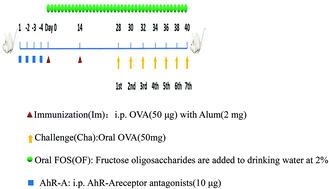Fructooligosaccharides protect against OVA-induced food allergy in mice by regulating the Th17/Treg cell balance using tryptophan metabolites
Abstract
Fructooligosaccharides (FOS) can change gut microbiota composition and play a protective role in food allergy (FA). Furthermore, the protective mechanism of FOS against FA is unclear. In this study, intestinal flora and tryptophan (Trp) metabolites were investigated in a mouse model with FA supplemented with FOS. Meanwhile, we injected aryl hydrocarbon receptor antagonists (AhR-A) into a mouse model of FA supplemented with FOS to investigate whether T helper cell (Th) 17/regulatory T (Treg) cell balance was affected. Our research studies showed that dietary intake of FOS provided moderate protection from the intestinal inflammation induced by ovalbumin (OVA). This protective effect disappeared in AhR-A mice. The OVA mice manifestations had significantly lower bacterial richness, when compared to the normal control (NC) mice. Among fecal bacteria, the abundance of Akkermansiaceae (family level) and Verrucomicrobia (phylum level) increased and Ruminococcacere (phylum level) decreased in the feces of allergic mice. These changes were reversed by FOS treatment. FOS modulated the gut microbiome profiles that were altered in OVA mice, which showed an increase in the abundance of Ruminococcacere (phylum level) and a decrease in the abundance of Akkermansiaceae (family level) and Verrucomicrobia (phylum level). Liquid chromatography/tandem mass spectrometry (LC-MS/MS) analysis of Trp metabolites showed significant reductions in the level of kynurenine (kyn) in the serum of OVA mice, as compared to NC and FOS mice. Conversely, the levels of Trp and 5-hydroxytryptamine (5-HT) were significantly increased in OVA mice. Correlation analysis revealed a negative relationship between the relative abundance of Verrucomicrobiae (class level) and Akkermansiaceae (family level) with kyn, and a positive relationship with 5-HT. FOS significantly reduced interleukin-17A (IL-17A) and retinoic acid-associated nuclear orphan receptor-γt (RORγt) in FOS mice but not in AhR-A mice. FOS increased the level of interleukin-10 (IL-10) and Forkhead box P3 (Foxp3) in FOS mice but not in AhR-A mice. These findings suggest that FOS ameliorates allergic symptoms and impacts Th17/Treg balance in mice by modulating the gut microbiota composition and Trp metabolites. FOS may serve as an effective tool for the treatment of FA by regulating immune and gut microbiota.



 Please wait while we load your content...
Please wait while we load your content...